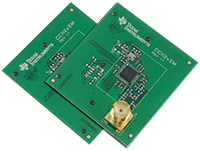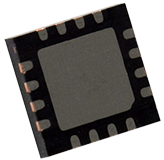 MCUs Series - Part 2 - Wireless MCUs
MCUs Series - Part 2 - Wireless MCUs
With the proliferation of communicating-hardware devices that use microcontrollers, it has become necessary to combine both the processing and communication functions to create easy to use devices. And many applications today use not only microcontrollers, but they also have a need for nodes communicating with each other and/or a central controller. To illustrate this direction, let's consider the Internet of Things (IoT) applications.
Related Components | Test Your Knowledge 
Due to the Internet of Things (IoT), just about every device, appliance, and even light bulbs are expected to collect and process data and then communicate it to a central point, which in turn commands what actions (e.g., actuations) need to take place. Sports/fitness, smart buildings, smart grids, smart cities, businesses – almost anything may benefit from such an arrangement.
IoT use cases already exist. They range from wearables that can monitor our fitness, sports achievements, or physiological functions, to applications such as smart homes, smart buildings, smart cities and smart grids. Often these applications require a sensing unit to communicate information while collecting it. In sensor networks, we see a similar need for nodes to be collecting and communicating data simultaneously. By combining the radio and the microcontroller functions into a single integrated chip, significant system design advantages are applied in these applications.
2. Objective
The objective of this learning module is to provide you with an overview of Wireless Microcontroller Units (MCUs).
Upon completion of this module, you will be able to:
- Define the unique characteristics of a wireless MCU
- Examine networking and communication concepts
- Explain the differences between various radio communication protocols
- Discuss the characteristics and benefits of different types of wireless MCUs
3. Networking and Communication Concepts
For well-disciplined use of the radio frequencies, regulatory bodies (such as the Federal Communications Commission, FCC, in the US) manage the use of frequency bands in countries around the world. Interference can be a major problem and these regulatory bodies manage frequency allocations judiciously so as to minimize interference between various applications that make use of the Radio Frequency Spectrum.
Most frequency bands are licensed (usually purchased through auctions), while a few (such as the 2.4 GHz or 5 GHz) are left as unlicensed or free-to-use. Recently, the FCC has been experimenting with a new Spectrum Access in the 3.5 GHz band through the Citizen's Broadband Radio Service (CBRS) governed by a Spectrum Access System (SAS) where emerging Dynamic Spectrum Access (DSA) is being applied.
When there is a network of nodes communicating together to achieve some system goals, the nodes need to follow a communication protocol. Such protocols need to be standardized such that interoperability is ensured between devices from different manufacturers.

In the Internet, all communications use a suite of protocols called the TCP/IP suite. TCP/IP uses 5 layers of the well-known and idealized 7-layer protocol standards OSI model proposed by the ISO. This is indicated in the Fig 1 to the left.
The application layer is for running the applications that depend on the service provided by the lower layers. Transport layer functions support end-to-end transport of data between two computers communicating across the Internet. With regard to the TCP/IP set of protocols, TCP or the transmission control protocol fulfills that role when reliable communication is desired; user datagram protocol (UDP) is the unreliable alternative. The network layer is intended to handle transmission of data packets via the intermediate nodes within a network, which is known as the routing function, IP or the Internet Protocol that does the job. The data link layer is responsible for point-to-point communication between one node to the next. Ethernet is an example of a vastly popular data link layer protocol, though it is common to see Wi-Fi since so many applications are evolving to wireless.
It is worth noting that both Ethernet and Wi-Fi are actually MAC (Medium Access Control) protocols. The MAC layer is considered a sub-layer of the Data Link Layer, and the other sub-layer is the Logical Link Control (LLC). Explaining the difference between the two is beyond the scope of this piece and would be the subject of its own Essentials' learning module. For all practical purposes we can consider Ethernet, Wi-Fi, etc. to be the Layer 2 or Link Layer protocol.
Incidentally, the two extra layers in the ISO-OSI model are called the session and presentation layers, which land between the application and transport layers. These layers have some utility in theory, but in practice their functions are performed by a combination of the other layers (usually the application layer). The Internet doesn't fit the model because it was already firmly in place when the OSI model was designed retrospectively. For an entertaining discussion of how these extra impractical layers came about see Computer Networks by Andrew Tanenbaum.
4. Typical Radio Communication Protocols Supported
There are many different types of radio communication protocols. In this section, we will examine the most common ones used today.
- Wi-Fi: This is the most widespread wireless standard. The IEEE 802.11 standard applies. Several versions have been issued to upgrade data throughput and other capabilities over time, with the current one being 802.11ac. A low power version for scenarios such as IoT is taking shape in the form of 802.11ah. Wi-Fi was developed to work with Ethernet (and as mentioned earlier, it also works with the same LLC sub-layer) and is now a part of the standard TCP/IP suite.
- Bluetooth: Popular use cases include phone-to-headset communications, music streaming from phone-to-speakers, etc. It offers point-to-point or star topology and can support data rates of up to 2 MB/sec. A recent version is Bluetooth Low Energy (BLE or Bluetooth Smart) and offers lower power operation in which devices can operate for years with coin cells. With BLE, newer applications such as, health and fitness wearables, toys, automotive and industrial, are becoming popular. Bluetooth can support up to 8 devices in a star topology. The BLE/Smart version has device support that is unlimited. However, in real applications 10 to 20 devices is usually the limit because they would still be in a broadcast domain sharing the same spectrum. BLE like the original Bluetooth works in the 2.4 GHz unlicensed ISM band that is also used by Wi-Fi and a host of other applications such as wireless/cordless phones, baby monitors, etc. Bluetooth is designed to automatically hop around interference in its Spread Spectrum Hopping Scheme and, therefore, is likely to use less than the available 79 channels in practical situations.
- ZigBee: The IEEE 802.15.4 standard defines ZigBee. It is a low throughput, low power, and low cost method of implementing a data link protocol standard. Data throughput can be up to 250 Kbps. ZigBee has become popular in smart energy, home automation, lighting control applications, wireless sensor networks, and industrial applications. ZigBee needs to operate through a gateway to be able to communicate with a TCP/IP implementation (to make a switch at layer 2). The gateway works as a node in the mesh that runs a full TCP/IP stack connecting the ZigBee layer 2 network to the Internet.
- 6LowPAN: This standard is defined by the Internet Engineering Task Force (IETF) and was released on Sept 2011 as a "Compression Format for IPV6 Datagrams over IEEE 802.15.4 based Networks." 6LowPAN defines an adaptation layer that makes the IEEE 802.15.4 ZigBee layer work well with the TCP/IP stack. 6LoWPAN often means the combination of ZigBee link layer, the IP compression layer, and the TCP/IP stack. In this way, ZigBee can support a large mesh network reliably, provide low power operation and is IPv6 ready.
- RF4CE: This is a standard defined for two-way communications for ultra-low power input devices for consumer electronic units such as a remote control. RF4CE is one of the profiles defined in the ZigBee standard and is for consumer electronic devices.
- Sub-1 GHz: While most applications operate in short ranges and very low power, there are some applications that require more transmission power. A portion of the sub-1 GHz band that is unlicensed makes communications within a home or bigger building possible. This could be useful in smart security solutions, consumer applications and safety applications. The frequencies used are 315 MHz, 433 MHz, 500 MHz, 868 MHz, 915 MHz, and 920 MHz bands.
- Proprietary 2.4 GHz: Industrial applications use proprietary protocols when using radios in this band. The radio acts as just the PHY and the data link layer; the rest of the layers are required to be developed, as needed.
- NFC: Near field communications have become quite popular in recent times. This enables data exchange between devices with very low power capacity, or even zero power, which makes possible applications such as passing a smartphone over a point-of-sale (POS) terminal for contactless payments. These actions typically take place at 13.56 MHz.
5. What is a Wireless MCU?
Wireless MCU devices combine microcontroller functionality with radio communication functions on a single integrated chip. Such integrated circuits are commonly known as a "system on a chip" or SOC devices. In the previously published ESSENTIALS learning module about ultra-low power MCUs, we have seen microcontrollers with components in addition to the microprocessor being integrated on a single circuit. These components include program storage memory, system memory, general purpose I/O pins, interrupt pins and registers.
The additional components allow for easy deployment of an MCU into a variety of applications. By integrating some radio frequency (RF) functionality into the chip, a single integrated module can be created to handle the radio, as well as the control requirements, leading to an even wider variety of applications. These kinds of devices are known as wireless MCUs. Several semiconductor device makers, such as Texas Instruments (TI), Freescale, Silicon Labs, Microchip, NXP, Marvel, and others, produce a range of wireless MCU devices. TI's device range is very extensive.
- 5.1 A Typical Wireless MCU SOC
Texas Instrument's SimpleLink Wireless MCU family is a good example of a wireless MCU SOC. See Fig 2.
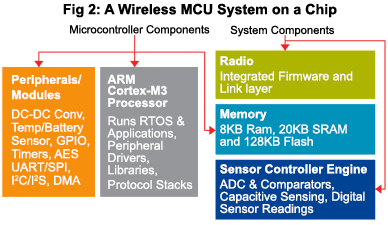
The peripheral sub-units indicated in the diagram include many common functionalities required by MCUs. The processor unit helps run (1) the operating system (such as a real time OS or RTOS), (2) drivers required for peripherals, libraries, and (3) the communication software stacks. Memory is also required for the processor to execute software.
In addition, other blocks have been integrated onto the chip. The radio block implements the radio functionalities, and the SCE block helps manage sensors. It provides the analog-to-digital conversion (ADC) facilities for reading data from analog sensors. It helps reading sensors that provide digital outputs. Capacitive-sense functions that help create convenient touch user interfaces are often also integrated on the MCU SOC nowadays.
- 5.2 A Simple Wireless MCU Example
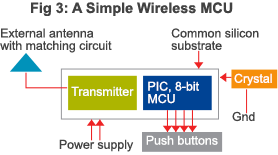
Another example of a simple device that has a radio transmitter built into the chip is a Microchip PIC 8-bit microcontroller (Fig 3 to the left).
This device's operating voltage is 1.8V – 3.6V, with a corresponding low current consumption. The transmitter operates in two bands in the sub-1 GHz band. There are four variants (PIC12F529T48A/T39A and PIC12LF1840T48A/T39A) of the device, offering different amounts of program memory and two frequency bands in the unlicensed portion of the sub-1 GHz band, which is available in most countries. These devices are suitable for simple applications such as: garage door openers, remote keyless entry devices, wireless sensors, etc.
Two other significant features that are offered by most manufacturers are the availability of a development board and royalty free communication software stacks. The benefit of this is little or no development time or royalty costs are needed to develop the communication software. Distributing it along with the application code is free since the communication software offers royalty free code by most manufacturers.
6. Types of Wireless MCUs
Wireless MCU devices are available as a part of the Texas Instruments' Wireless Connectivity product family. The family is partitioned into several categories and each of these are useful for various wireless solutions. Fig 4 summarizes the product tree. The largest category is the SimpleLink, which contains 4 other sub-categories.

- 6.1 Wireless Microcontrollers

CC1350 SimpleLink
|

CC2640 SimpleLink
|

CC3200 SimpleLink
|

RF430CL330H Dynamic NFC Interface TransponderRF430 MCUs: This family helps implement NFC/RFID systems. They come with a tightly coupled MCU and RF components needed for the NFC applications at 13.56 MHz. Low consumption passive circuitry helps run the system on coin cells for a long time. These are based on the MSP430 core. NFC or the “near field communications” technology has been gaining traction for some time. It is good for contactless data transfer applications. In some low energy applications, sensor tags carrying data can be built that do not require any on-board energy, not even a coin cell. The RF430CL330H is one example of this sub-category. |

CC430F5137 Ultra Low Power Microcontroller SoC with Integrated RF Transceiver CoreCC430 Wireless MCU: They have a sub-1GHz radio integrated with receiver of high sensitivity. They can operate with different modulation methods and offer different data rates. This family is based on the MSP430 family of MCU devices. These devices help bring personal and industrial wireless networking to the mass market. The CC430F5137 is one example of this sub-category. Note: The communication stack software development will have to be undertaken; there is nothing ready-made. |
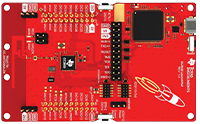
LAUNCHXL-CC2650 SimpleLink CC2650 Multi-standard Wireless MCU LaunchPadWireless MCUs are often featured in development kits to simplify the testing and experimenting process during product and system development. The LAUNCHXL-CC2650 LaunchPad is an example that features the SimpleLink |
- 6.2 Smart RF Transceivers
|
These are transceivers or radio devices that can be interfaced with an MCU to create a wireless MCU solution. But they are not strictly wireless MCU devices as defined earlier in this learning module. The radios can support one or more of the wireless communication supported by the SimpleLink |
- 6.3 Wireless Network Processors
 CC3100MOD SimpleLink
|
- 6.4 Range Extenders
7. Wi-Link 8 Combo Solutions
8. Working with The SimpleLink Devicese
Devicese
Let's look at two TI products, CC1310 and CC3200, as examples of devices that are in use today.
- 8.1 The SimpleLink CC1310
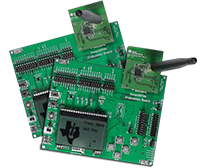 SimpleLink
|
- 8.2 The SimpleLink CC3200
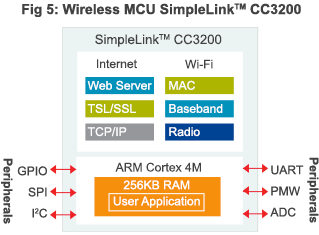
The SimpleLink Development of a product with a wireless MCU will be similar, irrespective of the manufacturer that provides the device. With its extensive device support, TI also offers an extensive set of development hardware, software/firmware tools, communication stacks (certified or otherwise). The actual tools used will vary somewhat with the family chosen for development of an application. The following looks at the development process and the tools used for a multi-protocol project for IoT applications, in brief. To begin, wireless MCUs have ultra-low power microcontrollers. We discussed the power management aspects of an ultra-low power design in the previous Essentials series. Due to the addition of the wireless component, some amount of complexity is added to the power management. Higher power consumption can be caused by software-related issues, duty cycle issues, and issues with the wireless network itself. One of the crucial points to remember is that the wireless environment is often much less reliable and more prone to interference than wired communication. This leads to expending more energy to transmit the same amount of information. Settings in the wireless MCU chips can partially remedy the power situation. In the CC32xx family devices, these settings can save a significant amount of power. See the blog post from TI's E2E community website for a discussion of optimizing power consumption in an application over Wi-Fi using SimpleLink There are two options available for an integrated development environment (IDE) when working with the CC3200. One is the Code Composer Studio (CCS) and the other is the IAR embedded Workbench. TI created the Code Composer Studio for its own products. CCS has been derived from the widely-used Eclipse IDE code base. There is a cloud-based version available. The free version provides a set of tools that may be enough for hobbyists and DIYers. IAR Embedded Workbench is not specific to any manufacturer. We take the SimpleLink The software development kit available with this bundle has some 40 odd Wi-Fi examples, Internet applications and MCU peripheral programs. The SDK also provides driver support. The USB and the JTAG interfaces can be used to connect the board directly to PC. Both 4-wire JTAG and 2-wire Serial Wire Debug (SWD) interfaces are available. The PC will help run the IDE tools. They can also help downloading application code to the board when ready. When downloading the SDK from TI, access to the communication stack firmware is made available. This stack helps provide certified compliance for the protocols to be used. The board provides connector pins as headers for adding boosterpacks for additional functionality, if needed. GNU debugger is supported on-board via Open On-Chip Debugger (OpenOCD). |
*Trademark. Texas Instruments , and TI are trademarks of Texas Instruments, Inc. Other logos, product and/or company names may be trademarks of their respective owners.
, and TI are trademarks of Texas Instruments, Inc. Other logos, product and/or company names may be trademarks of their respective owners.
Test Your Knowledge
Microcontroller Skills 2

Are you ready to demonstrate your wireless microcontrollers knowledge? Then take a quick 15-question multiple choice quiz to see how much you've learned from this Essentials MCUs 2 module.
To earn the MCUs 2 badge, read through the module to learn all about wireless microcontrollers, attain 100% in the quiz, leave us some feedback in the comments section.

